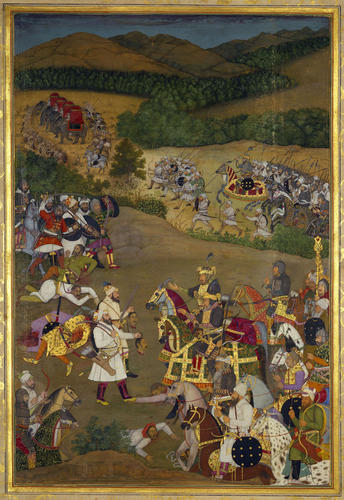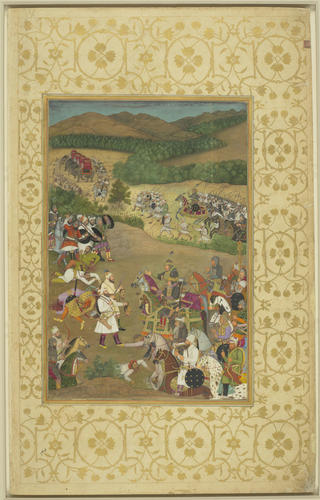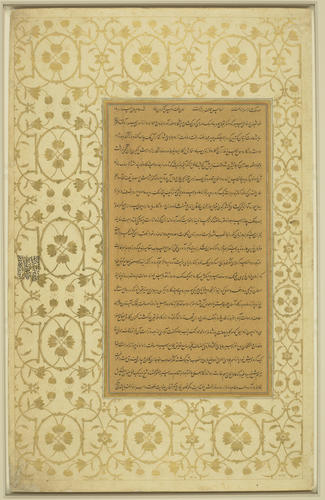-
1 of 253523 objects
Khan Dawran receiving the heads of Jujhar Singh and his son Bikramajit (January 1636) c. 1640-50
Painting in opaque watercolour including metallic paints. | 35.7 x 23.9 cm (image) | RCIN 1005025.ak

Attributed to Payag
Master: Padshahnamah پادشاهنامه (The Book of Emperors) Item: Khan Dawran receiving the heads of Jujhar Singh and his son Bikramajit (January 1636) c. 1640-50

Attributed to Payag
Master: Padshahnamah پادشاهنامه (The Book of Emperors) Item: Khan Dawran receiving the heads of Jujhar Singh and his son Bikramajit (January 1636) c. 1640-50

Attributed to Payag
Master: Padshahnamah پادشاهنامه (The Book of Emperors) Item: Khan Dawran receiving the heads of Jujhar Singh and his son Bikramajit (January 1636) c. 1640-50



-
Padshahnamah fol. 176v
(plate 36)
Abdullah Khan and Khan-Dawran receive the heads of Jujhar Singh Bundelah and Bikramajit Jag-Raj to send to Shah-Jahan.
After the Mughal army stormed the Orchha Fort in late 1635 (see RCIN 1005025.aj), the rebellious Jujhar Singh and his son Bikramajit attempted to hide in the nearby forest where they were discovered murdered by members of the local Gond tribe. According to the Padshahnamah text, when Khan Dawran heard this news, ‘he rode to where the traitors’ bodies were and ordered their heads, which were beehives of sedition and corruption, to be severed from their bodies’. It is this moment that is captured in the foreground of the painting, after he ordered the dispatch of their severed heads and their rings, horses and personal insignia to Shah-Jahan as evidence confirming their identities.
The two Mughal generals are depicted in full armour on horseback, just below the centre of the painting. They receive the turbanless heads dripping with blood and with their eyes rolled back, the bodies lying in heap behind them. Some of their followers are also shown captured and killed by the imperial troops, two of their bodies shown being trampled on. The scene takes place outside forest in which they hid. In the background, a group of elephants with covered howdahs contain Rani Parbati and the other women of Jujhar Singh’s household who were taken captive, along with their jewels, coins and other possessions.
The painting is unsigned but thought to have been painted by Payag.
Bibliography:
Milo Beach and Ebba Koch, King of the world : the Padshahnama, an imperial Mughal manuscript from the Royal Library, Windsor Castle, 1996
Saqib Baburi, Beyond the Akbarnamah: Padshahnamahs and Official Regnal Chronography for Shah-Jahan Padshah (r. 1037/1628-1068/1658), 2010.Provenance
Illustration from a Padshahnamah manuscript formerly in the Mughal imperial library and acquired by Asaf al-Dawlah, Nawab of Awadh, c.1780-90; presented by Saadat Ali Khan, Nawab of Awadh, to George III via Lord Teignmouth in June 1799.
-
Creator(s)
Acquirer(s)
-
Medium and techniques
Painting in opaque watercolour including metallic paints.
Measurements
35.7 x 23.9 cm (image)
58.4 x 36.7 cm (page dimensions)
Category